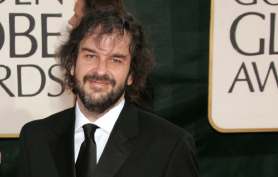The Hobbit Movie
 Making the Hobbit movie was a long story. First, there is a misconception that the first Hobbit cartoon was filmed in 1966 by Rankin/Bass. Actually, the 1966 animated adaptation of The Hobbit was actually a short animation created for television directed by Gene Deitch. This adaptation is notably different from the Rankin/Bass production of The Hobbit in 1977, which is more widely recognized and was better received. The 1966 version was a very brief, approximately 12-minute film, created in a rush to help William L. Snyder maintain his option on the adaptation rights to the story.
Making the Hobbit movie was a long story. First, there is a misconception that the first Hobbit cartoon was filmed in 1966 by Rankin/Bass. Actually, the 1966 animated adaptation of The Hobbit was actually a short animation created for television directed by Gene Deitch. This adaptation is notably different from the Rankin/Bass production of The Hobbit in 1977, which is more widely recognized and was better received. The 1966 version was a very brief, approximately 12-minute film, created in a rush to help William L. Snyder maintain his option on the adaptation rights to the story.
This animated adaptation diverged significantly from J.R.R. Tolkien’s classic novel. The plot follows a homebody hobbit who embarks on a quest to save dwarven treasure from a dragon. The dragon, named Slag, burns the city of Dale to the ground and steals its treasures, including the Arkenstone. Only three survivors remain: Princess Mika, General Torin Oakenshield, and an unnamed watchman. Seeking revenge, they enlist the help of the wizard Gandalf the Grey.
Gandalf selects Bilbo Baggins as their dragon-slayer. Initially reluctant to leave his peaceful home, Bilbo falls for Princess Mika and takes on the quest for her sake. Along their journey, Bilbo’s companions are captured by goblins who intend to eat them. Bilbo cleverly manipulates the Groans into fighting each other until sunlight kills them.
Despite its rushed production—completed in less than a month—the film fulfilled Snyder’s licensing contract with Tolkien’s estate. It was shown at three separate screenings for industry professionals.
It was a low-budget project that saw limited release, primarily intended to fulfill contractual obligations rather than to be a faithful or comprehensive adaptation of J.R.R. Tolkien’s beloved book. Its reception was largely obscure due to its limited exposure and the fact that it was overshadowed by subsequent adaptations, including the 1977 Rankin/Bass animated TV movie and Peter Jackson’s live-action film series. The studio Rankin/Bass also created an animated feature for TV in 1977.
The Rankin/Bass animated adaptation of The Hobbit received mixed reviews at first, but generated some interest in a live-action version. Attempts to produce The Hobbit films in the late 1990s failed because of the complex rights situation involving multiple companies like United Artists, Tolkien Enterprises, and New Line Cinema.
Peter Jackson’s Vision of Hobbit movie
Attempts to create The Hobbit movie in the late 1990s did not materialize. The rights were scattered across multiple companies – United Artists, Tolkien Enterprises, New Line Cinema – creating a tangled legal web.
Peter Jackson, having just directed the epic Lord of the Rings trilogy, set his sights on The Hobbit in 1995. But wrestling the rights from the studios proved more difficult than Bilbo snatching the One Ring from Gollum. Complex negotiations, twists of fate, and the allure of Middle-Earth riches finally united all parties.
After Jackson’s Lord of the Rings became a box office hit, studios craved more. MGM acquired distribution rights in the late ’90s, but still needed New Line’s production rights and Jackson’s cinematic talent. In 2006, MGM brought all parties to the table. And in December 2007, it was announced Jackson would direct two Hobbit films for New Line and MGM, targeting 2010 and 2011 releases.
Peter Jackson’s vision for Hobbit movie was hands-on, technically expert, and creative. He maintained tight creative control over the film franchise, demonstrating reverence for the source material and commitment to a unique cinematic experience.
However, production faced numerous delays due to financial issues and expanding the adaptation into a trilogy. Changes in studio ownership and financing also contributed to postponing the project.
Despite challenges, the first film of the trilogy, The Hobbit: An Unexpected Journey, released in 2012, with the trilogy concluding in 2014. The films were well-received by eager fans who had awaited another Middle-Earth cinematic journey for years.